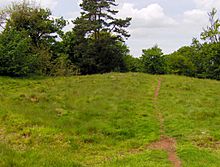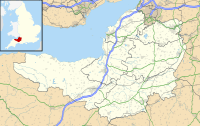Richmont Castle facts for kids
Quick facts for kids Richmont Castle |
|
|---|---|
| East Harptree, Somerset | |

Site of Richmont Castle
|
|
| Coordinates | 51°17′59″N 2°37′47″W / 51.2996°N 2.6296°W |
| Type | Keep and bailey |
| Site information | |
| Owner | Private |
| Condition | Earthworks and limited masonry remain |
Richmont Castle was an old castle from the 11th century (that's the 1000s!). It was a special type called a "motte-and-bailey" castle. You could find it near East Harptree in Somerset, England. Today, it's mostly ruins, but it used to have a big park, a man-made lake, and even a court for local mining.
Contents
Where Was Richmont Castle?
Richmont Castle was built close to East Harptree in Somerset. It was likely built soon after the Norman conquest of England in 1066. The name "Richmont" probably means "rich mountain" or "strong mountain."
The castle sat on a steep piece of land. It looked out over the Chew Valley. Two smaller valleys, called coombes, dropped down on either side of the castle's spot.
The Castle's Story
Early Days and Design
The first version of Richmont Castle likely had one main area, called a bailey. This was on the south side. It might have even used an old Iron Age fort that was already there.
Later, the castle grew. An inner bailey was added inside the first one. A round tower, called a keep, was built on the highest point. The castle became part of a planned landscape. It was surrounded by a large park, known as the Great Park. The keep might have even looked over a man-made lake.
A person named William FitzJohn de Harptree might have been the one who started building the castle.
Richmont Castle During the Anarchy
In the 12th century, Richmont Castle was part of a big civil war. This war was called the Anarchy. It was a fight between King Stephen and the Empress Matilda to control England.
Sir William de Harptree controlled Richmont Castle. He supported Empress Matilda. In 1138, King Stephen tried to capture Bristol but failed. Then, he moved towards Richmont Castle.
Stories say Stephen captured the castle using a clever trick. He set up his siege engines far away from the castle. When the castle's defenders came out to attack him, Stephen quickly rushed forward. His soldiers burned the main gates behind the defenders. This allowed him to successfully take the castle.
Later Use and Royal Visits
King John also visited the castle in 1205. For most of the Middle Ages, the de Harptrees and de Gurney families used the castle. It was an important place. It served as the main office and law court for one of the four lead mining areas in the Mendip region.
Why Was Richmont Castle Abandoned?
By the 1540s, Richmont Castle was in ruins and no longer used. Its stones were taken and used to build houses nearby. A family called the Newtons even dug up the foundations to build their house, "Eastwood."
Between the 1600s and 1800s, people mined the castle site a lot. They dug for lead and calamine. These materials were used in factories in Bristol.
Today, the site is a scheduled monument. This means it's a protected historical place. You can still see a small piece of the old keep there.


